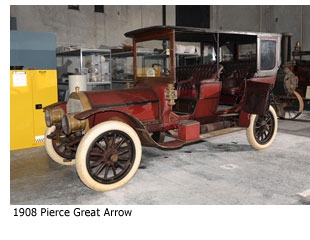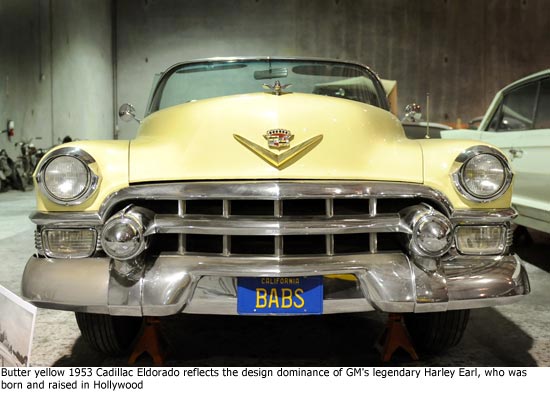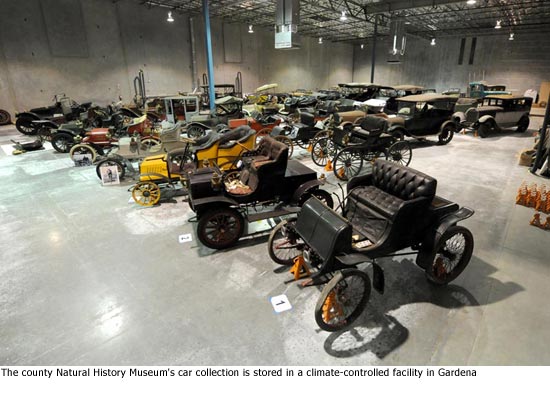Baby, you can’t drive these cars
June 24, 2010
Ah, that old car smell. Step inside the anonymous-looking Gardena warehouse and breathe it in: History. Glamour. Prestige. And a big ol’ steam-powered tractor, complete with dirt-encrusted tires, that Hollywood’s Edgar Bergen drove around his orange grove in the San Fernando Valley.
Stashed away in this unlikely location is one of the country’s most intriguing collections of 75 vintage vehicles, owned by what may seem like an equally unusual collector—the County of Los Angeles.
The county-run Natural History Museum came into possession of the cars when it parted ways with the Petersen Automotive Museum in 2007 as part of a divvy between the two. The Petersen, now a private non-profit institution, kept cars that had been given to its foundation over the years, while the Natural History Museum kept those that had been given to the county by such benefactors as Bergen’s widow, who donated the tractor.
The county collection has been largely off the general public’s radar, although experts and researchers use it heavily and individual cars have been displayed at the Natural History Museum, the Petersen and at other facilities and events.
Now the public is about to get a look. This fall, the museum plans to start offering behind-the-scenes tours one day a month at its Gardena collections facility.
Museum officials also are attempting to refine the collection’s mission—an exercise that includes deciding which vehicles are most important to keep. Their report to the Board of Supervisors is expected by the end of the month.
Will the 1963 Rolls-Royce Silver Cloud III, donated to the county by a Pasadena doctor, make the cut? How about those two rumble seat-equipped Model As? Or the gleaming black 1932 Duesenberg roadster, its imposing body designed at Pasadena’s Walter Murphy coachworks?
Museum officials won’t say which, if any, vehicles may be moving on. But their goal is to focus on vehicles that have a story to tell about Los Angeles and California—especially those that remain in authentic, unrestored condition, with their “cultural DNA intact,” in the words of John Long, the museum’s vice president for research and collections.
“A lot of our cars aren’t wonderfully polished and looking like they’re straight off the showroom floor,” he says.
Some are, of course—like a bright yellow 1927 McFarlan roadster. “It’s totally historically inaccurate, but it’s a gorgeous piece of eye candy,” says the museum’s collections manager, Beth Werling.
The current belle of the garage, however, is an exceptionally rare 1908 Pierce Great Arrow touring car made in Buffalo, N.Y., once owned by the wife of the editor of the San Francisco Examiner. It’s massive and imposing, even regal, with gold monograms on its wine-red doors.
The vehicle is said to be the only one of its kind in original, unrestored condition—something that auto connoisseurs find interesting these days, it turns out.
The Great Arrow’s been invited to participate in the Concours d’Elegance car exhibition in Pebble Beach in August, where Pierce cars will be a particular focus.
“The Concours d’Elegance is the most prestigious car show in the world right now,” Werling says. “Being invited is like being nominated for an Oscar.”
The Concours selection committee is even footing the bill for transporting the car to and from Pebble Beach. “It’s a magnificent car,” says Martin E. Button, who’s on the selection committee and whose company, Cosdel International Transportation, specializes in the import and export of collector cars from around the world.
“It is the only one that is unrestored and in original condition—which is really important…I have a 1909 Pierce Arrow that’s not nearly as rare as this.”
And one of these years—maybe this one—an unrestored car may win big at the Concours.
“We’ve never had an unrestored car win Best of Show, but everybody wants it to happen,” Button says. “We’d love to see that.”
 In order to have a shot at rolling over the ramp to a moment of glory in front of the Lodge at Pebble Beach, a car has to actually be drivable, which presents a bit of a problem. The Great Arrow, which was running in 1998 when it previously was exhibited at Pebble Beach as part of the Petersen’s collection, now has a gummed-up carburetor. It’s on its way to a specialty mechanic.
In order to have a shot at rolling over the ramp to a moment of glory in front of the Lodge at Pebble Beach, a car has to actually be drivable, which presents a bit of a problem. The Great Arrow, which was running in 1998 when it previously was exhibited at Pebble Beach as part of the Petersen’s collection, now has a gummed-up carburetor. It’s on its way to a specialty mechanic.
“We’re scrambling to find funding to get it up and running,” Werling says. “We’re not sending it to Pep Boys.”
Werling, who has degrees from Stanford and NYU, also manages Natural History Museum collections ranging from jewelry (“We have Pio Pico’s rosary”) to aircraft (“We have a glider and we have a bi-plane.”) Her previous professional experience with vehicles was limited to tractors at an agricultural museum in Arkansas.
“It’s been a big new world,” she says. “It’s a very complex artifact to take care of.”
As she moves through the collection, Werling points out two types of cars with California links. For some, the connection is obvious—they were made here during the city’s early 20th century burst of automotive entrepreneurial spirit. In this category are the two 1902 Tourists, for example, made by downtown L.A.’s once dominant Auto Vehicle Company.
Then there’s the second category—cars made elsewhere but that reflect something about the California people who made or used them.
Take, for example, the butter yellow 1953 Cadillac Eldorado, to be displayed as part of the museum’s multifaceted Southern California history exhibit “Under the Sun” when it debuts in 2012. The car’s design is the work of the legendary Harley Earl, who was born and raised in Hollywood and went on to fame as head of General Motors’ style department. He got his start in his father’s Earl Automotive Works in Los Angeles, going on to create showy vehicles for Silent Era film stars before Detroit lured him away.
Like the Cadillac, other vehicles have ties to an earlier Los Angeles, a time when local road races became fodder for the era’s moviemakers. The museum’s 1915 Stutz White Squadron Race Car (currently on loan to the Petersen) appeared in an early movie in which a real racecar driver, Earl Cooper, played the love interest to Mabel Normand.
A Jaguar 1954 XK-120 coupe in the collection speaks to Los Angeles’ emergence as a sports car capitol after World War II. “We had the roads that you could drive them on,” Werling says. Those images reached the rest of the country—and the world—by way of Hollywood movies. And the rest, as they say, is history.
When it comes to the stories behind the cars, it’s hard to beat the jaunty red1904 Franklin that staged one of the first cross-county road trips—with Pasadena mechanic Lester Whitman at the wheel—and later survived the San Francisco earthquake. After the quake, as fires raged, the plucky vehicle helped ferry survivors across the bay to Oakland, losing its wicker basket trunk to burning embers in the process.
Now it’s time to present those stories—and the collection as a whole—to the public.
“They’ve got some great cars down there, they really do,” says Button, of the Pebble Beach Concours d’Elegance selection committee. “You have some wonderful cars and I think they’re a real attraction. I just think it’s a real shame to have cars stashed away.”
Focusing on “preservation cars” like the Pierce Great Arrow might be a good niche to develop as the museum refines its collection. “There are no museums that do that,” Button says. “One of the sayings we have, and you can quote it, is: You can’t restore originality.”
By the way, don’t expect any cross-town rivalry from Leslie Kendall, curator of the Petersen Automotive Museum, who says he’d welcome the opening of the Natural History Museum’s collection to the public for tours.
“I can’t get enough,” Kendall says. “I love the idea that there’d be another place I could see great cars.”
Photos by Scott Harms/Los Angeles County
Posted 6/24/10































 405 bridge work causes a stink
405 bridge work causes a stink